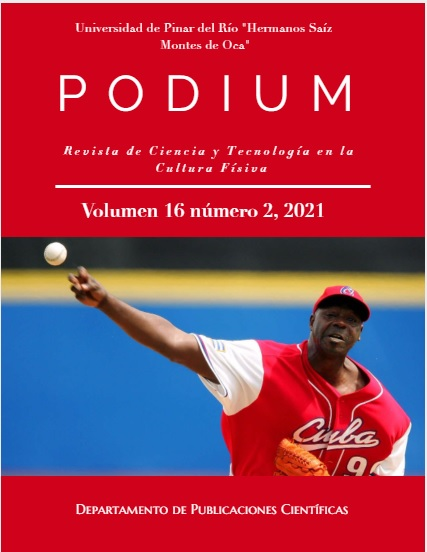Mejora del rendimiento post-activación con banco plano o landmine en la fuerza del golpe recto/Post-activation performance enhancement with bench press or landmine on straight punch strength
Contenido principal del artículo
Resumen
Descargas
Detalles del artículo
Citas
Balmaseda, M. (2011). Anaìlisis de las acciones teìcnico-taìcticas del boxeo de rendimiento. Universidad del paiìs Vasco. Facultad de Ciencias de la Actividad Fiìsica y el Deporte departamento de Educacioìn Física y Deportiva. Tesis doctoral.
Botcazou, M; Zouhal, H; Jacob, C; Gratas-Delamarche, A; Berthon, P; Bentué-Ferrer D. & Delamarche, P. (2006). Effect of training and detraining on catecholamine responses to sprint exercise in adolescent girls. European Journal of Applied Physiology. DOI: 10.1007/s00421-006-0131-y.
Cairns, S. P. & Borrani, F. (2015). â-adrenergic modulation of skeletal muscle contraction: key role of excitation-contraction coupling. J Physiol. DOI:10.1113/JP270909.
Cairns, S. P. &Dulhunty, A. F. (1993). The effects of beta-adrenoceptor activation on contraction in isolated fast and slow-twitch skeletal muscle fibres of the rat.Br. J. Pharmacol. DOI:10.1111/j.1476-5381.1993.tb13932.x.
Cuenca-Fernández, F; Smith, I; Jordan, M; MacIntosh, B; López-Contreras, G; Arellano, R. & Herzog, W. (2017). Non-localized post-activation performance enhancement (PAPE) effects in trained athletes: a pilot study. Applied Physiology Nutrition and Metabolism. DOI: 10.1139/apnm-2017-0217.
Decostre, V; Gillis, J. M. & Gailly, P. (2000). Effect of adrenaline on the post-tetanic potentiation in mouse skeletal muscle. J. Muscle Res. Cell Motil. DOI:10.1023/A:1005685900196.
Dimitrios, L; Forsythy, J; Liossis, G. & Tsolakis, C. (2013). The Acute Effect of Upper-Body Complex Training on Power Output of Martial Art Athletes as Measured by Bench Press Throw Exercise. Journal of Human Kinetics. DOI: 10.2478/hukin-2013-0079.
Güllich, A. & Schmidtbleicher, D. (1996). MVC-induced short-term potentiation of explosive force. N Stud Athlet.
Jones, M; Oliver, J; Delgado, J; Merrigan, J. & Andrew, R. (2018). Effect of Acute Complex Training on Upper Body Force and Power in Collegiate Wrestlers. Journal of Strength and Conditioning Research Publish Ahead of Print DOI: 10.1519/JSC.0000000000002508.
Lenetsky, S; Harris, N. & Brughelli, M. (2013). Assessment and Contributors of Punching Forces in Combat Sports Athletes: Implications for Strength and Conditioning. Strength and Conditioning Journal. DOI: 10.1519/SSC.0b013e31828b6c12.
Lesinski, M; Muehlbauer, T; Busch, D. & Granacher, U. (2013). Acute effects of postactivation potentiation on strength and speed performance in athletes. SportverletzSportschaden. DOI: 10.1055/s-0033-1335414.
Lowery, R. P; Duncan, N. M; Loenneke, J. P; Sikorski, E. M; Naimo, M. A; Brown, L. E. & Wilson, J. M. (2012). The effects of potentiating stimuli intensity under varying rest periods on vertical jump performance and power. The Journal of Strength & Conditioning Research. DOI: 10.1519/JSC.0b013e318270fc56.
MacIntosh, B. R; Robillard, M. E. & Tomaras, E. K. (2012). Should post-activation potentiation be the goal of your warm-up? Appl. Physiol. DOI:10.1139/h2012-016.
McGowan, C. J; Pyne, D. B; Thompson, K. G. & Rattray, B. (2015). Warm-up strategies for sport and exercise: mechanisms and applications. SportsMed. DOI:10.1007/s40279-015- 0376-x.
Merlo, R. (2012). Efectos del entrenamiento de la potencia en el golpe recto de boxeo con la máquina powermerlo. Tésis doctoral. Universidad de Baja California. Tépic, Nayarit.
Merlo, R. (2019). Entrenamiento para Deportes de Combate: Bases Científicas, Teóricas y Prácticas para la preparación de un peleador. León: CPLED.
Pic-Aguilar, M., Sánchez-López, C., & Blanco-Villaseñor, A. (2016). Caracterización del `Knockout' en Boxeo. Cuadernos De Psicología Del Deporte, 16(1), 85-94. https://revistas.um.es/cpd/article/view/254391
Picón-Martínez, M; Chulvi-Medrano, I; Cortell-Tomo, J. y Cardozo, L. (2019). La potenciación post-activación en el salto vertical: una revisión. FederacioìnEspanÞola de Asociaciones de Docentes de Educacioìn Fiìsica (FEADEF). DOI: https://doi.org/10.47197/retos.v36i36.66814.
Rhea, M. R; Alvar, B. A; Burkett, L. N. & Ball, S. D. (2003). A meta-analysis to determine the dose response for strength development. Medicine & Science in Sports & Exercise. DOI: 10.1249/01.MSS.0000053727.63505.D4.
Siff, C. & Verhoshansky, V. (2004). Supertraining. ISBN: 84-8019-465-0.
Suchomel, T. J; Lamont, H. S. & Moir, G. L. (2016). Understanding vertical jump potentiation: A deterministic model. Sports Medicine. DOI: 10.1007/s40279-015-0466-9.
Tillin, N. A. & Bishop, D. (2009). Factors modulating post-activation potentiation and its effect on performance of Subsequent explosive activities. Sports Med. DOI: 10.2165/00007256-200939020-00004.
Trimble, M. H. & Harp, S. S. (1998). Post-exercise potentiation of the H-reflex in humans. Med Sci Sports Exerc. DOI: 10.1097/00005768-199806000-00024.
Whelan, N; O'Regan, C. & Harrison, A. J. (2014). Resisted Sprints do not acutely enhance sprinting performance. J Strength Cond Res. DOI: 10.1519/JSC.0000000000000357.


